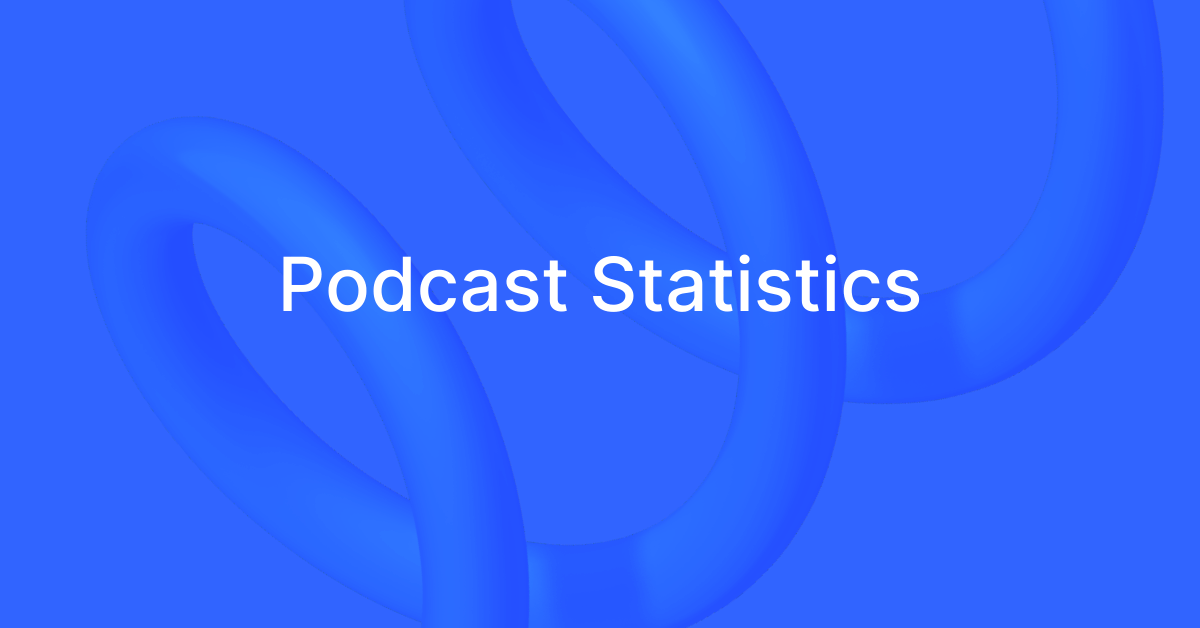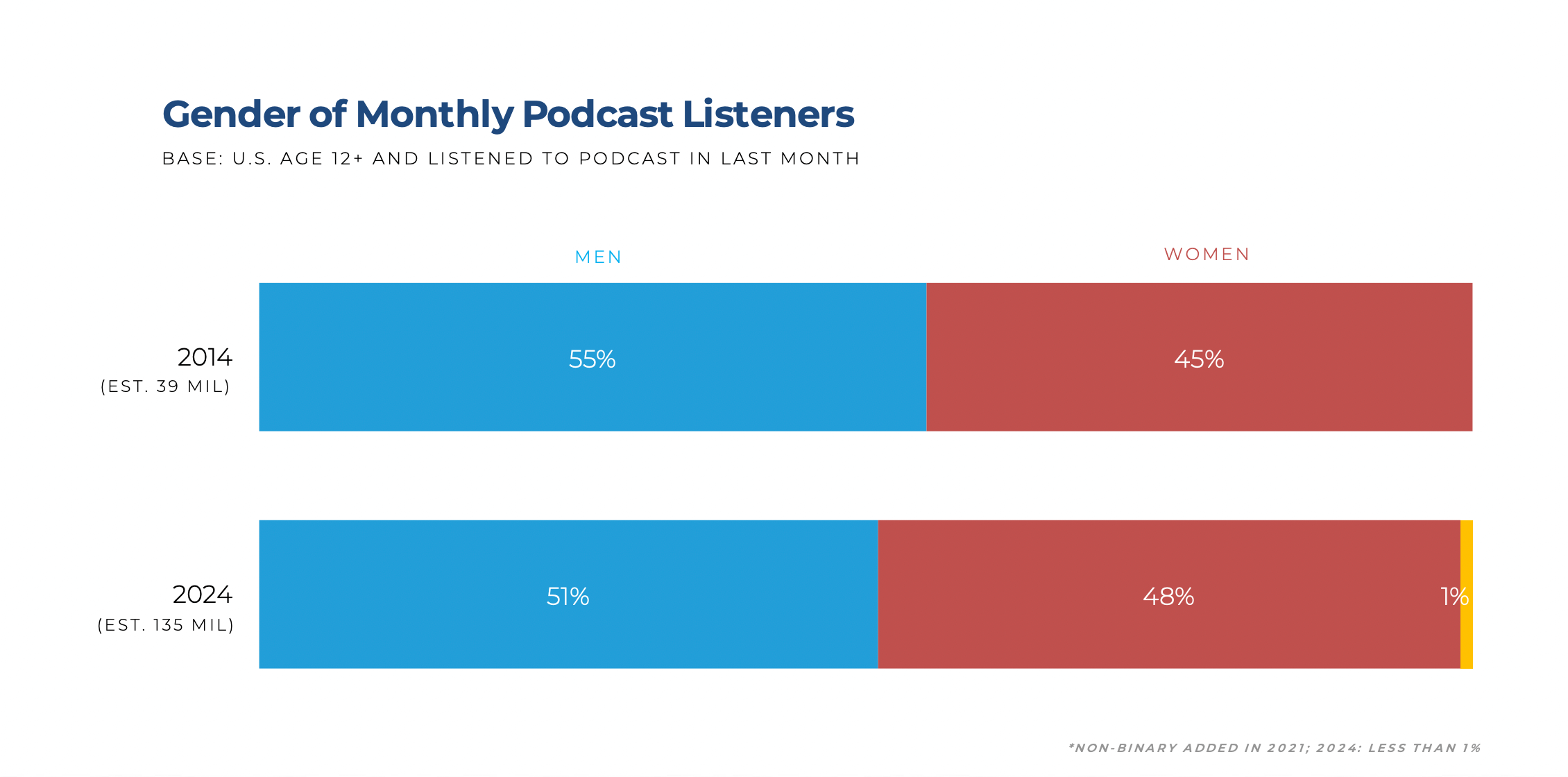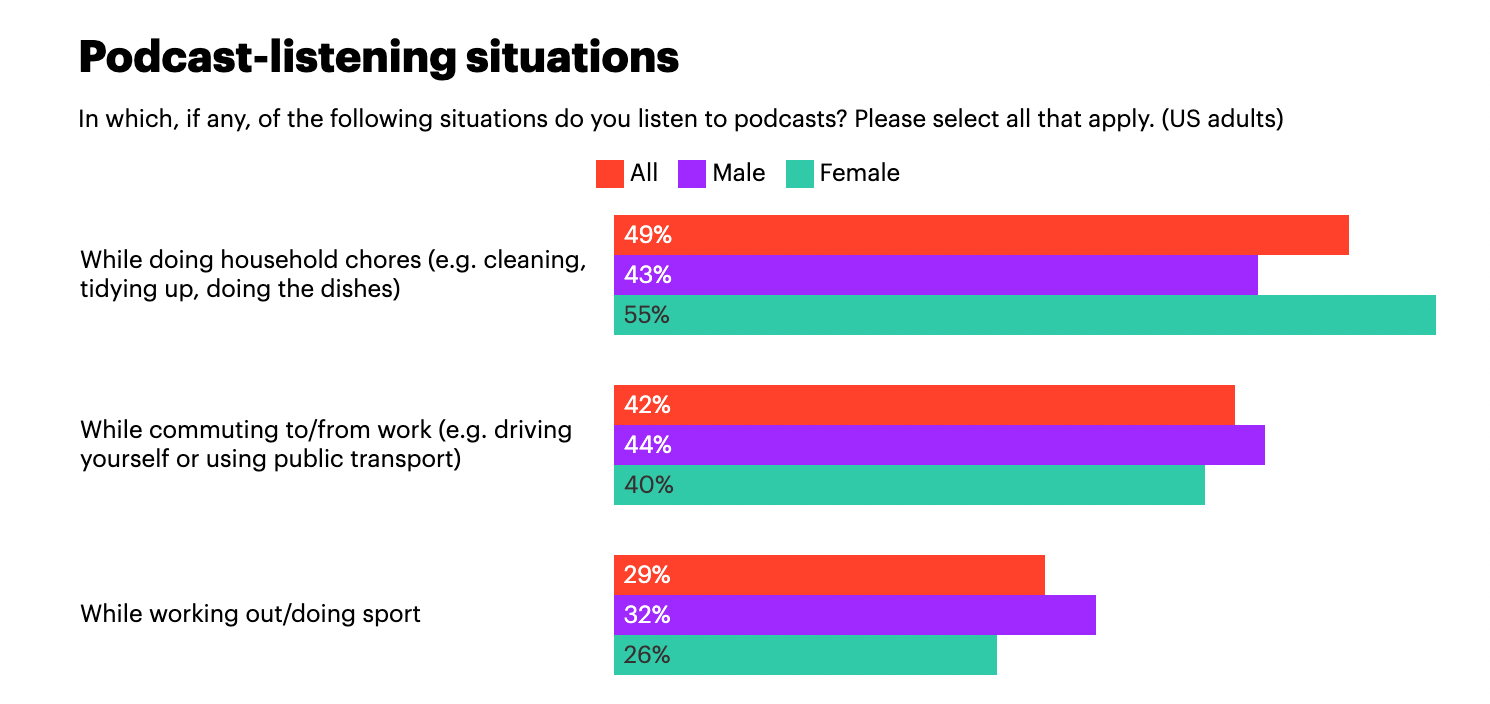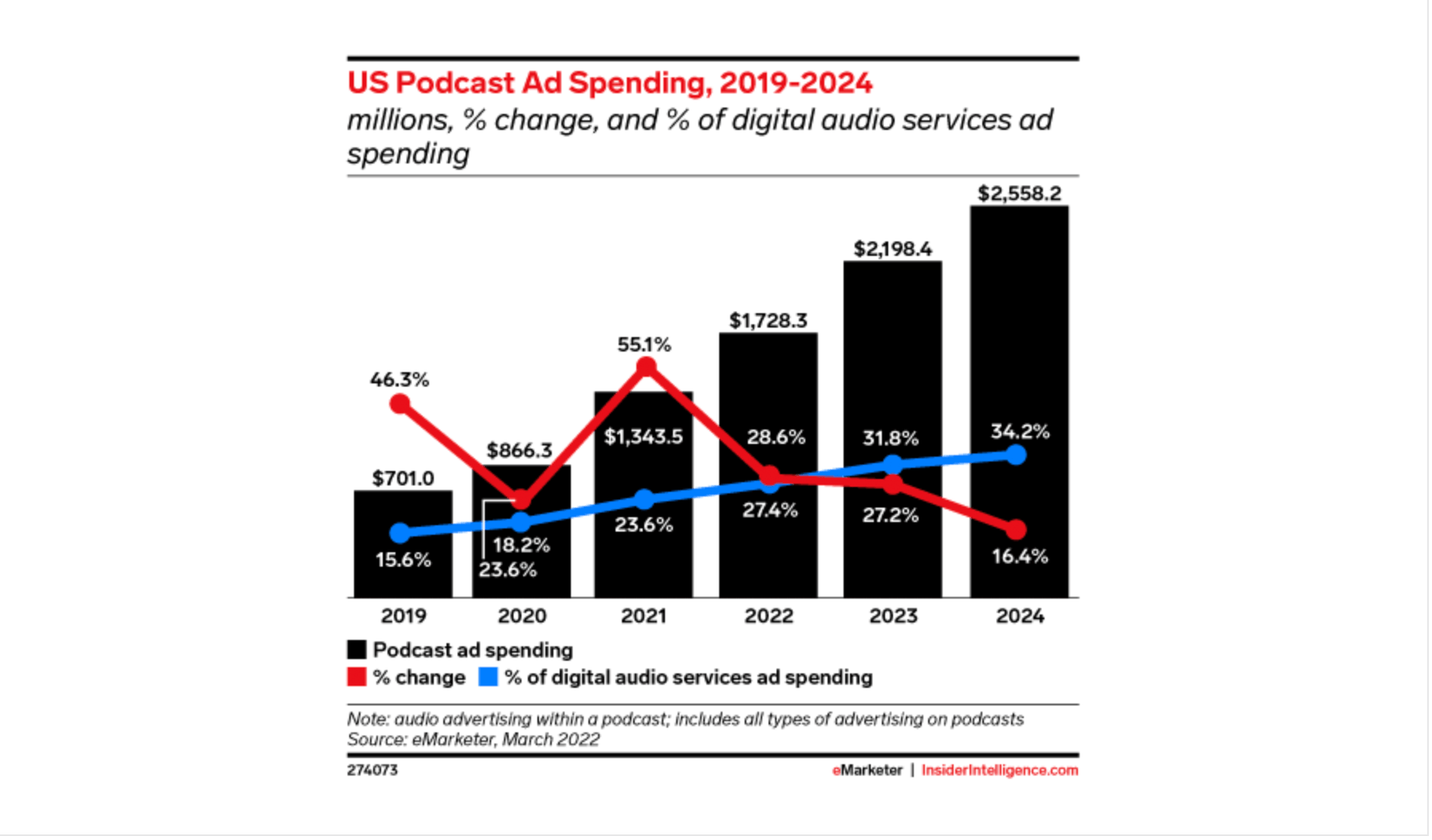
40+ Podcast Stats & Industry Trends Need to Know in 2025
98% accurate, real-time transcription in just a few clicks. 58 languages and multiple platforms supported.
If you choose to open Spotify or any other audio platform and find a podcast you could listen to today, you'd be spoilt for choice by the number of options available. With everything from technology, culture, health and nutrition, and finance, you can choose from several options based on your interests. To help you out, I’ve created a list of 40+ podcast statistics that can help you create a winning strategy for 2025.
Podcast stats (top picks)
The number of people listening to podcasts has increased from 506.9 million in 2023 to 546.7 million in 2024.
Those between the ages of 12 and 34 are the biggest consumers of podcasts.
70% of the total weekly podcast audience listens to podcasts on a mobile phone, with 88% using Apple Podcasts and 79% using Spotify.
US podcast ad spending was estimated to reach $2.56 billion by 2024, a 16.4% year-over-year increase.
Overview of the podcast industry
As the introduction mentioned, the global podcast market has grown significantly over the years.
Brief history and growth of podcasts
The number of podcast listeners in North America, Latin America, China, and Western Europe has risen from 506.9 million in 2023 to 546.7 million in 2024.
By 2027, the combined listener base of these regions is predicted to hit a whopping 651.7 million.
In the US alone, the share of monthly podcast listeners among those over the age of 12 was 9% in 2008 and has increased to 47% in 2024.
The share of time spent listening to audio sources was 2% in 2014, and it rose to 11% in 2024.
The average time spent listening to podcasts has grown by 450% since 2014.
Source: eMarketer, Edison Research
Popularity and current state of podcasting
Today, podcasting is one of the most preferred forms of content consumption globally.
As of October 2022, YouTube was the most preferred platform for listening to podcasts in the US, at 33%.
In second place was Spotify, with 24% saying they preferred it and 12% showing their preference for Apple Podcasts. Among the other platforms, you have Pandora, Amazon Music, and iHeartRadio, among others, in decreasing order of preference.
Sources: Edison Research, Spotify
Podcast listener demographics
Understanding the demographic data behind podcast listeners is key to understanding audiences’ preferences. It can also help you target your product more effectively.
Age, gender, and location breakdown
Edison Research found that those between the ages of 12 and 34 are the biggest consumers of podcasts. In fact, 59% of those in this age bracket are monthly podcast listeners, whereas 43% are weekly podcast listeners.
As of 2024, 51% of monthly podcast listeners in the US are male, 48% are female, and 1% are non-binary.
Younger listeners also engage with and take recommendations from podcasts more than older listeners.
Sources: Edison Research, Pew Research Center
Educational background and income levels
Educational background and income levels also play a key role in the patterns identified in podcast consumption.
Of the entire American population (aged 18 and above), 56% of podcast listeners are not college-educated, which means 44% are.
Of monthly podcast listeners over 18 years of age, 51% are not college-educated, and 49% are.
Similarly, of the entire American population above 18 years of age, 52% earn less than $75K a year, while 48% earn $75K or more.
Sources: Edison Research
Device preferences
Interestingly, a vast majority of Apple Podcasts and Spotify’s audiences listen to podcasts on mobile devices. In contrast, a third of those who use YouTube to listen to podcasts use either a laptop or a TV.
70% of the total weekly podcast audience listens to podcasts on a mobile phone, with 88% using Apple Podcasts and 79% using Spotify.
A total of 12% of the weekly podcast audience uses a computer or a laptop to listen to podcasts, with the highest share among platforms going to YouTube at 21%, 3% to Apple Podcasts, and 8% to Spotify.
Sources: Cumulus Media
Podcast consumption habits
Understanding podcast consumption habits is also important for someone who wants to enter the market, as it helps you refine how to cater to your target audience.
Time spent listening to podcasts
Audiences' time spent listening to podcasts offers unique and helpful insights. This time varies based on a range of factors, including income levels, age, and so on.
The average time spent on listening to podcasts has increased by 450% since 2014.
Gen Z podcast listeners who started listening to this format as children spend 3 hours a week more than those who started listening to podcasts later in life.
Between the ages of 12 and 34, 38% listen to podcasts for between an hour to three hours a week, and 22% listen to 10 hours or more of podcasts.
Sources: Edison Research
Most popular times to listen
The times and situations in which consumers listen to podcasts also say a lot about consumption patterns.
49% of listeners listen to podcasts while doing household chores such as cleaning, washing the dishes, or tidying up their home.
42% listen to podcasts while commuting to and from work, making the mornings and evenings among the peak times of podcast consumption.
Sources: YouGov
Frequency and platform loyalty
There are a few interesting insights into frequency and platform loyalty to consider.
As of October 2024, Spotify was #1 among all podcast platforms, with 46,780,272 downloads, which account for 41.5% of the total downloads for the month.
Apple Podcasts comes in second place with 34,326,595 downloads, which account for 30.4% of the downloads for the entire month.
Sources: BuzzSprout
Most popular podcast platforms
Users also have preferences regarding which platform they listen to podcasts on. In the sections below, I compare the top two platforms (Spotify and Apple Podcasts) and offer insights into other emerging platforms.
Spotify vs. Apple Podcasts
Spotify and Apple Podcasts are #1 and #2 when it comes to the most popular podcast platforms. Here is how the two compare:
According to data from February 2022, 32.5 million people in the US stated they listen to podcasts on Spotify, while Apple Podcasts had 28.5 million podcast listeners.
Spotify's and Apple's sales are projected to total 42.4 million and 29.2 million, respectively, by 2025.
As of October 2022, Spotify was the second most preferred platform for listening to podcasts, with 24%, while Apple Podcasts stood at 12%.
Other emerging platforms
Besides YouTube, Spotify, and Apple Podcasts, several other platforms have become more popular over time. Here are a few statistics that shed light on their adoption.
Some other emerging platforms on which consumers listen to podcasts include Pandora, Amazon Music, iHeartRadio, and SiriusXM.
As of October 2022, Pandora was the preferred platform among 7% of US users, while 6% stated they preferred Amazon Music, and another 6% stated their preference for iHeartRadio.
Sources: eMarketer
Types of podcasts and popular genres
Consumers also have certain preferences regarding the types of podcasts and genres they listen to.
Most popular genres
An understanding of the most popular genres of podcasts shows you what kind of content listeners are interested in.
Comedy is the most popular genre in terms of listening hours, with a share of 30%.
Society and culture come in second place, with a share of 18%.
This is followed by lifestyle and health at 15% and crime at 10%, while 7% of the total share goes to educational podcasts.
Sources: Statista, Pew Research Center
Niche podcast growth
Over time, certain niches have seen immense podcast growth.
Besides comedy, society and culture, and the news, some other niches that have seen an increase in consumption include education, which went up one rank between Q1 2023 and Q1 2024.
Religion and spirituality also went up one rank among the most popular genres in the same period.
Music went up two ranks, while fiction also went up two ranks.
Sources: Edison Research
Podcast advertising statistics
Given the popularity of podcasts, it’s no wonder that advertisers have tapped into the potential this medium offers.
Advertising revenue and growth
How much has the market for podcast advertising grown in the past few years? The statistics below offer a few key insights.
US podcast ad spending was estimated to reach $2.56 billion by 2024, a 16.4% increase from the previous year.
Worldwide ad spending for 2024 was predicted to hit a whopping $4.02 billion, a 16.18% year-over-year increase from 2023.
In fact, by 2027, podcast ad spending is forecasted to reach $5.03 billion.
Listener preferences for ads
What does the data on listeners’ preferences in terms of podcast advertising have to say? Here are a few key insights that can help.
In 2021, 51% of podcast super listeners said that they paid more attention to ads on podcasts than on any other medium, an increase from 48% in 2020.
49% stated they believed that the person hosting the podcast often uses the products or services they recommend.
Pre-recorded ads that the podcast host doesn’t read out are the least preferred form of ads among Super Listeners.
30% said that it’s important to them to limit their exposure to podcast advertising.
Sources: Edison Research
Types of brands investing in podcast advertising
Besides the advertising revenue and listener preferences, understanding which industries are spending heavily on podcast advertising is also a critical aspect to consider.
Arts, entertainment, and media were the biggest spenders on podcast ads in 2024, accounting for 14% of the revenue share.
This surpassed Financial Services, which was the biggest spender in 2023 with a 13% revenue share.
CPG also grew to 12% of revenue in 2023, while retail accounted for 11% in 2023, up from 9% in 2022.
Sources: Marketing Charts
Podcast industry trends
The podcast industry is evolving rapidly, with a few key trends shaping its future in 2025.
Growth of video podcasts
Video podcasts or videocasts have established a strong presence in the podcasting industry. As of April 2024, 33% of US weekly podcast listeners stated they prefer watching podcasts. In fact, as of July 2024, Spotify had over 250,000 video podcast shows on the platform.
Sources: Cumulus Media, Spotify
Increase in short-form podcasts
50% of podcasts are between 20-60 minutes long, while less than 10% are shorter than 10 minutes, and about 17% are longer than 60 minutes. With time, it is expected that short-form podcasts are likely to see an increase in consumption.
However, a survey conducted by The Podcast Host shows that 52.6% of people don’t care about the length of the podcast’s episode when they find an interesting episode.
Sources: BuzzSprout, The Podcast Host
AI and technology integration
The use of AI and technology in podcasting is set to grow tremendously. In fact, the Global AI in Podcasting market is expected to be worth around $26,599.1 million in 2033, up from 2,200.9 million in 2023.
Machine learning (ML) and cloud-based solutions will play a key role in the podcasting industry in the future. AI is also expected to play a key role in podcast transcription, especially among businesses that often need to repurpose content for multiple marketing channels.
Sources: Market
Notta can convert your spoken interviews and conversations into text with 98.86% accuracy in minutes. Focus on conversations, not manual note-taking.
Podcast statistics for businesses
Podcasts also offer businesses a great way of increasing brand awareness, generating thought leadership, and more.
How podcasts support brand awareness
Given podcasts' engaging nature, they offer an effective way of building awareness for your brand, its culture, values, and authenticity. As a result, they help build a deeper connection with your audience.
A few examples of successful branded podcasts include TGIM by Shopify and Inside Trader Joe’s by Trader Joe’s, both of which have captured their audience's attention and helped build greater brand awareness.
Employee training and internal podcasts
Podcasts are also effectively being used for internal communication within businesses. They can play a key role in offering training and development, onboarding new members, and giving them an overview of the organization and its policies and culture.
A notable example of an internal podcast is 'Truth and Reconciliation' by DropBox, which was launched in 2020 in response to the Black Lives Matter movement. It was launched to start a conversation about institutional racism and how to bring about change.
Benefits of podcasts for thought leadership
Branded podcasts are also a brilliant way to build thought leadership in your industry. By interviewing industry leaders, sharing expert insights, or discussing topics relevant to your industry, you can position your brand as an authoritative figure within your industry.
35% of senior executives or leaders listen to podcasts for the purpose of self-improvement, which further translates to how they leverage the information they gain to position their brands as thought leaders. What’s more, using podcasts also helps brands tap into the 'economy' in which consumers expect a lot more from brands than just a suite of products and services.
Sources: Signal Hill Insights
The bottom line
Podcasts have taken the media world by storm, and the growth of this format is set to increase over the next few years. This, in turn, is also expected to result in an increase in podcast ad spending, making it a medium with immense potential. On the consumer front, changing preferences and greater awareness are also leading to a steady rise in podcast consumption, as the podcast statistics above have demonstrated.


